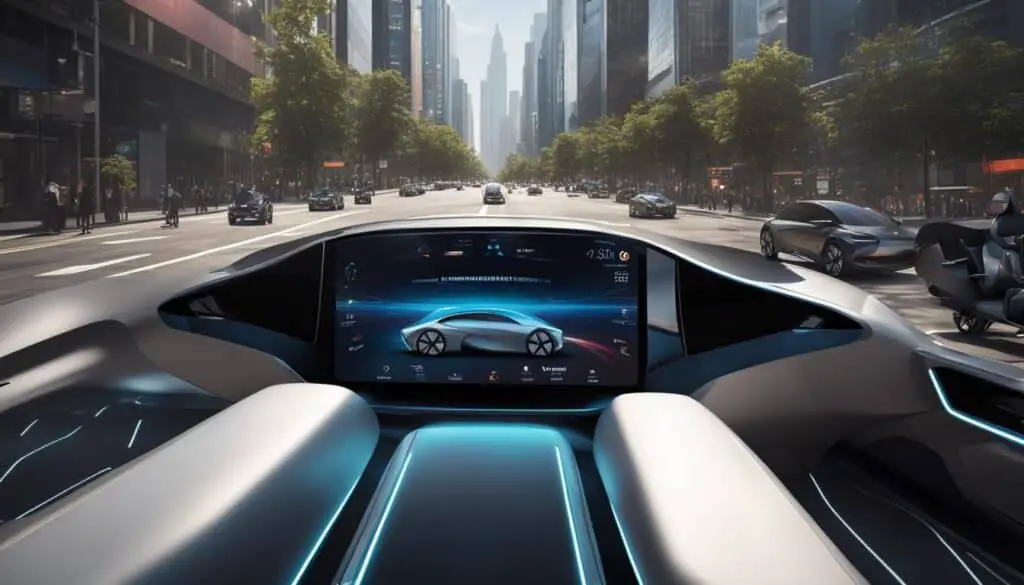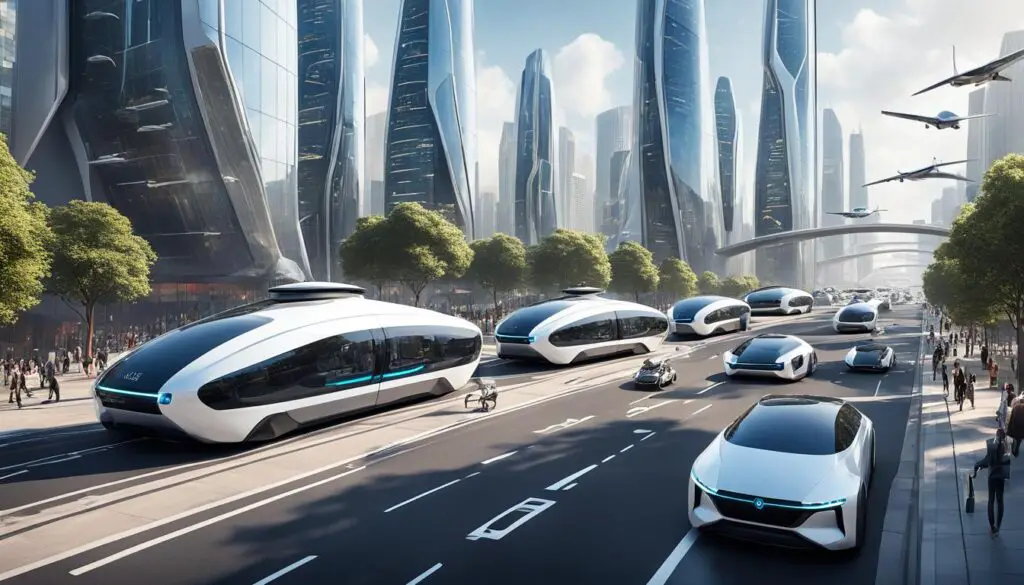
Ride-Sharing and Carpooling: The Future of Shared Mobility
Ride-sharing and carpooling have become increasingly popular in recent years and are expected to play a major role in the future of shared mobility. According to recent studies and reports, these trends are reshaping our travel habits and transforming the transportation industry. The rise of ride-sharing platforms like Uber and Lyft, along with the increasing adoption of carpooling services, has led to significant changes in how people get around. In this article, I will explore the latest trends in ride-sharing and carpooling and their potential impact on the future of shared mobility.
Key Takeaways:
- Ride-sharing and carpooling are on the rise and are reshaping our travel habits.
- Platforms like Uber and Lyft have significantly changed how people get around.
- Carpooling services are becoming more popular as an alternative mode of transportation.
- The future of shared mobility looks promising with advancements in technology.
- Ride-sharing and carpooling offer numerous benefits such as reducing carbon footprint and saving money on transportation costs.
The Benefits of Ride-Sharing and Carpooling
Ride-sharing and carpooling offer numerous benefits for both individuals and society as a whole. By sharing rides, commuters can reduce their carbon footprint, alleviate traffic congestion, and save money on transportation costs. In addition, ride-sharing and carpooling can provide convenient and flexible transportation options, especially in areas with limited public transit. These services also foster social connections and can improve the overall efficiency of transportation systems. With the advancement of technology and the emergence of new business models, the benefits of ride-sharing and carpooling are expected to increase in the future.
When it comes to ride-sharing benefits, one of the key advantages is the reduction in carbon emissions. By sharing a ride with others, fewer vehicles are on the road, leading to a decrease in air pollution and greenhouse gas emissions. This not only benefits the environment but also promotes sustainability and helps combat climate change.
Another major benefit of ride-sharing and carpooling is the alleviation of traffic congestion. As more people opt to share rides, there will be fewer single-occupancy vehicles on the road, resulting in smoother traffic flow and reduced congestion. This can ultimately save commuters time and reduce the frustration associated with daily commuting.
“Ride-sharing and carpooling can provide convenient and flexible transportation options, especially in areas with limited public transit.”
From a financial standpoint, ride-sharing and carpooling can help individuals save money on transportation costs. Sharing the expenses of fuel, tolls, and parking can significantly lower the overall commuting expenses. Additionally, some ride-sharing platforms offer cost-sharing options, allowing riders to split the fare, making it an affordable alternative to owning a car or relying solely on public transportation.
Ride-sharing and carpooling also have social benefits. By sharing a ride, commuters have the opportunity to meet and interact with people from different backgrounds, fostering social connections and expanding networks. Furthermore, shared rides can contribute to a sense of community and reduce social isolation, especially for individuals who may feel disconnected during their daily commute.
“The benefits of ride-sharing and carpooling extend beyond individual convenience and savings. These services have the potential to improve the overall efficiency of transportation systems.”
Lastly, the benefits of ride-sharing and carpooling extend beyond individual convenience and savings. By reducing the number of vehicles on the road, these services can improve the overall efficiency of transportation systems. This can result in improved traffic flow, decreased travel times, and a more sustainable use of existing infrastructure.
The advantages of ride-sharing and carpooling are undeniable. Not only do these services offer financial savings and convenience to individuals, but they also present significant environmental and societal benefits. As technology continues to advance and new business models emerge, the shared mobility benefits are expected to further enhance and reshape our transportation systems.
The Impact of Technology on Ride-Sharing and Carpooling
Technology has revolutionized the ride-sharing and carpooling industry, paving the way for a more efficient and convenient transportation experience. The emergence of ride-sharing apps, such as Uber and Lyft, has transformed the way people commute, making it easier than ever to connect with drivers and arrange shared rides.
These innovative platforms provide real-time information about driver availability, pricing, and optimal routes, ensuring a seamless experience for riders. With just a few taps on a smartphone, users can easily find a ride and reach their destination quickly and affordably.
Moreover, technology has enabled the integration of various transportation modes, such as public transit and biking, into ride-sharing and carpooling services. This integration promotes efficient transportation solutions, reducing the reliance on individual cars and decreasing overall traffic congestion on roads.
The use of advanced algorithms and data analytics has significantly improved the matching process, ensuring optimal driver-rider pairings and increasing the efficiency of shared rides. These technological advancements have not only reduced wait times for riders but have also optimized route planning, leading to more streamlined and cost-effective journeys.
Looking to the future, technology will continue to drive innovation in the ride-sharing and carpooling industry. The rise of autonomous vehicles and the development of electric cars present exciting opportunities for further advancements. As these technologies mature, we can expect safer and more sustainable transportation options, revolutionizing the way we commute.
“Technology has revolutionized the ride-sharing and carpooling industry, paving the way for a more efficient and convenient transportation experience.”
Technological Advancements in Ride-Sharing and Carpooling
In recent years, ride-sharing and carpooling apps have undergone significant advancements, enhancing the overall experience for both riders and drivers. Key technological advancements in this field include:
- Improved app interfaces and user experiences, leading to faster and more intuitive booking processes.
- Integration with GPS and mapping technologies for real-time tracking and optimal navigation, ensuring smooth and efficient rides.
- Enhanced driver and rider safety features, including driver background checks, vehicle inspections, and in-app emergency assistance.
- Integration of cashless payment systems, providing seamless and secure transactions.
- Integration with public transit systems, allowing riders to combine multiple modes of transportation for a complete journey.
These advancements have transformed ride-sharing and carpooling into an efficient, reliable, and environmentally friendly transportation option for commuters worldwide.
Technological Advancements in Ride-Sharing and Carpooling
| Advancement | Description |
|---|---|
| Improved App Interfaces | Faster and more intuitive booking processes, making it easier for users to request rides. |
| GPS and Mapping Integration | Real-time tracking and optimal navigation for smooth and efficient rides. |
| Enhanced Safety Features | Driver background checks, vehicle inspections, and in-app emergency assistance to ensure the safety of both drivers and riders. |
| Cashless Payments | Integration of secure and convenient payment systems for seamless transactions. |
| Integration with Public Transit | Combining ride-sharing and carpooling with public transit options for a comprehensive transportation experience. |
These technological advancements have reshaped the ride-sharing and carpooling landscape, providing individuals with accessible and sustainable mobility solutions.

Challenges and Potential Solutions for Ride-Sharing and Carpooling
While ride-sharing and carpooling offer many benefits, they also face various challenges. One of the main challenges is the issue of trust and safety. Riders need to feel comfortable sharing a vehicle with strangers, which can be a barrier to adoption. Additionally, the availability and convenience of other transportation options can impact the demand for ride-sharing and carpooling services. If there are convenient alternatives like public transit or affordable parking, individuals may opt for those instead.
Another challenge is the need for infrastructure and policy support to encourage the adoption of shared mobility solutions. Without proper infrastructure, such as dedicated carpooling lanes or designated pick-up and drop-off spots, ride-sharing and carpooling can become less efficient and appealing.
Trust and Safety
Trust and safety are crucial factors that influence the success of ride-sharing and carpooling. Riders need reassurance that they are safe when sharing a ride with strangers. To address this challenge, improved background checks, reliable driver ratings, and comprehensive insurance policies can enhance safety and build trust among riders. Ride-sharing platforms can implement stringent screening processes and provide transparent driver rating systems to ensure the safety of their users.
Availability of Convenient Alternatives
The availability and convenience of alternative transportation options can discourage individuals from choosing ride-sharing and carpooling. For example, if public transit is reliable, affordable, and easily accessible, people may be more inclined to use it instead of sharing rides. To overcome this challenge, ride-sharing and carpooling services need to focus on providing additional value and convenience to their users. This can be achieved by integrating with public transit systems or offering seamless connections between different modes of transportation, making ride-sharing and carpooling a more attractive and convenient option.
Infrastructure and Policy Support
To encourage the adoption of shared mobility solutions, there is a need for infrastructure and policy support. Governments, transportation authorities, and city planners can play a crucial role in promoting and facilitating ride-sharing and carpooling. The development of dedicated carpooling lanes, priority parking for shared rides, and strategic pick-up and drop-off zones can enhance the efficiency and convenience of ride-sharing and carpooling services. Partnerships between ride-sharing platforms and public transit agencies can also help integrate these services into existing transportation networks, providing a comprehensive and interconnected mobility system.
Addressing these challenges is essential for the widespread adoption and success of ride-sharing and carpooling. By implementing solutions that promote trust and safety, improve convenience, and foster infrastructure and policy support, shared mobility can flourish, offering sustainable and efficient transportation options for individuals and communities.
The Future of Ride-Sharing and Carpooling
The future of ride-sharing and carpooling holds great promise, with experts anticipating continued growth and innovation in the industry. Technological advancements, such as autonomous vehicles and electric cars, are projected to revolutionize the landscape of ride-sharing. These innovations will not only enhance convenience and efficiency but also contribute to reducing carbon emissions and promoting sustainability.
An important trend that is expected to gain traction in the coming years is the integration of ride-sharing and carpooling with public transit systems. This integration will provide passengers with seamless, multimodal transportation options, making it easier for individuals to combine different modes of travel in their daily commute. By offering a more integrated and convenient transportation experience, this trend has the potential to further reduce traffic congestion and enhance the overall efficiency of urban mobility.
In addition to technology-driven changes, regulations and policies aimed at promoting shared mobility and sustainable transportation are forecasted to drive the future adoption of ride-sharing and carpooling services. Governments worldwide are recognizing the environmental and societal benefits of shared mobility and are taking steps to incentivize its usage. These measures may include providing preferential treatment for ride-sharing and carpooling vehicles, offering tax incentives, and implementing dedicated infrastructure for shared mobility solutions.
Overall, the future of ride-sharing and carpooling looks promising, with continuous growth, advancements in technology, and the support of regulations and policies focused on sustainable and shared mobility. As we move forward, it is crucial for businesses, governments, and individuals to embrace these trends and contribute to the development of a more efficient, environmentally friendly, and accessible transportation system.

Predicted Boost in Ride-Sharing and Carpooling
As we look ahead, here are some predictions for the future of ride-sharing and carpooling:
- Autonomous Vehicles: The advent of autonomous vehicles is expected to revolutionize the ride-sharing and carpooling industry. Self-driving cars can potentially reduce the cost of shared rides, increase accessibility, and enhance safety.
- Electric Cars: The growing popularity of electric vehicles is likely to have a significant impact on ride-sharing and carpooling. With the increased availability and affordability of electric cars, the environmental benefits of shared mobility are expected to be amplified.
- Integration with Public Transit: The integration of ride-sharing and carpooling with public transit systems will provide commuters with more efficient and convenient travel options. This integration will make it easier for individuals to combine different modes of transportation to reach their destinations.
- Sustainable Policies: Governments worldwide are expected to implement policies and regulations that promote shared mobility and reduce the environmental footprint of transportation. These initiatives may include incentives for ride-sharing and carpooling, the development of dedicated infrastructure, and stricter emission standards.
| Predictions for the Future of Ride-Sharing and Carpooling |
|---|
| Advancement of autonomous vehicles will revolutionize the industry |
| Increase in electric cars will enhance environmental benefits |
| Integration with public transit will provide seamless travel options |
| Government policies will support and promote shared mobility |
Conclusion
The future of shared mobility is poised to be revolutionized by the continued growth of ride-sharing and carpooling. These trends offer a multitude of benefits, from reducing our environmental impact to alleviating traffic congestion and enhancing transportation efficiency. As technology advances, we can expect further innovation in the industry, particularly with the integration of autonomous vehicles and the seamless merging of ride-sharing and carpooling with other modes of transportation.
Despite the challenges that ride-sharing and carpooling face, such as safety concerns and the need for policy support, the prospects for their future are promising. These trends are set to reshape the way we travel and commute in the years to come. It is crucial for individuals, businesses, and policymakers to embrace and support shared mobility for the development of a sustainable and efficient transportation system.
By embracing ride-sharing and carpooling, we can collectively contribute to reducing our carbon footprint, improving traffic flow, and creating more connected and accessible communities. As we move forward, let us embrace the future of shared mobility and work together to create a transportation landscape that is both environmentally friendly and economically viable.
FAQ
What are the benefits of ride-sharing and carpooling?
Ride-sharing and carpooling offer several benefits, including reducing carbon footprint, alleviating traffic congestion, saving money on transportation costs, providing convenient transportation options, fostering social connections, and improving transportation efficiency.
How has technology impacted the ride-sharing and carpooling industry?
Technology has played a crucial role in the growth of ride-sharing and carpooling. Mobile apps have made it easier for riders to connect with drivers and arrange shared rides, providing real-time information about driver availability, pricing, and routes. Technology also enables the integration of other transportation modes into ride-sharing and carpooling services, and the use of advanced algorithms improves the matching process and increases ride efficiency.
What challenges do ride-sharing and carpooling face?
One of the main challenges is the issue of trust and safety, as riders need to feel comfortable sharing a vehicle with strangers. The availability and convenience of other transportation options can also impact the demand for ride-sharing and carpooling services. Additionally, infrastructure and policy support are needed to encourage the adoption of shared mobility solutions.
What are the potential solutions to the challenges faced by ride-sharing and carpooling?
Improved background checks, driver ratings, and insurance policies can enhance safety and build trust among riders. Partnerships with public transit agencies and the development of dedicated carpooling lanes can make ride-sharing and carpooling more attractive options.
What does the future hold for ride-sharing and carpooling?
Experts predict continued growth and innovation in the ride-sharing and carpooling industry. Advancements in technology, such as autonomous vehicles and electric cars, are expected to reshape the ride-sharing landscape. Integration with public transit systems is also likely to increase, providing seamless and convenient multimodal transportation options. Regulations and policies aimed at promoting sustainable and shared mobility are expected to drive further adoption of ride-sharing and carpooling services.
